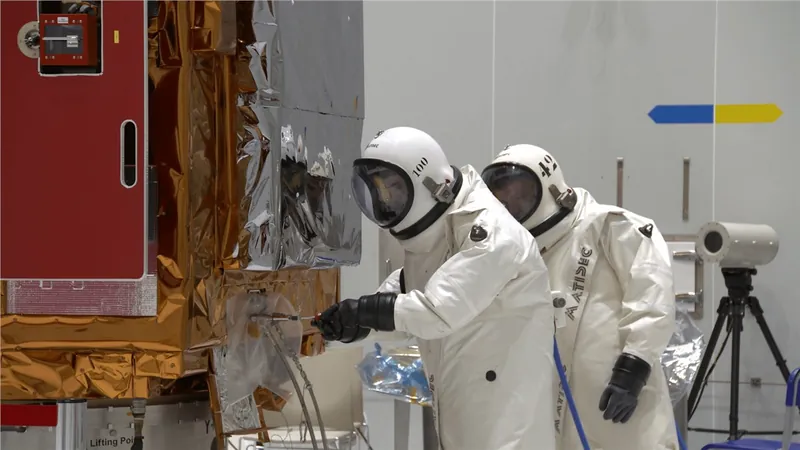
Revolutionary Discovery: High Heat Enhances Stability of Key Material for Medical Implants
2025-03-31
Author: Rajesh
Introduction
In an exciting breakthrough, a collaborative team of scientists from Rice University, the University of Cambridge, and Stanford University has transformed the way a crucial material used in medical implants and computing applications is produced. This material, a conductive polymer known as PEDOT:PSS, has been instrumental for over two decades, yet a chance experiment has led to significant advancements.
The Discovery
Historically, researchers relied on a chemical crosslinker to ensure the stability of PEDOT:PSS in water. However, during trials to develop precise patterns for biomedical optics, Siddharth Doshi, a Stanford doctoral student working alongside Rice materials scientist Scott Keene, made an unexpected modification: he omitted the crosslinker and increased the preparation temperature. To their astonishment, the material remained stable without the additional chemical.
"This find was serendipitous—we were shocked that it worked so well without following the traditional recipe," remarked Keene, emphasizing the delightful surprise that sparked deeper investigation into this novel method.
Significance of the Findings
What they discovered was remarkable: heating PEDOT:PSS to higher temperatures not only negated the need for a crosslinker but also significantly enhanced the quality of the resulting devices. Their findings, published in the journal *Advanced Materials*, indicate that this innovative approach could simplify the manufacturing of bioelectronic devices, paving the way for advancements in neural implants, biosensors, and cutting-edge computing technologies.
What is PEDOT:PSS?
PEDOT:PSS is a blend of two polymers: one that effectively conducts electronic charges and another that conducts ionic charges and dissolves in water. This dual capability makes it uniquely suitable for bridging the gap between biological tissues and electronic devices. As Keene explained, "It allows interaction at the neural level, speaking the language of the brain."
Enhanced Properties of the New Method
The shifts in electrical conductivity and stability offered by this new method are critical. By omitting the crosslinker—a substance that historically bonded polymer strands and introduced potential toxicity—they produced a material that maintains three times the electrical conductivity and consistent stability across production batches, key for medical applications.
The traditional crosslinker secured the polymer strands together but left vulnerable areas where instability could arise. In contrast, increased heat induces a phase change that reorganizes the water-insoluble components, ensuring a cleaner, more stable final product.
Addressing Challenges in PEDOT:PSS Use
"We have effectively tackled many issues that researchers faced with PEDOT:PSS," said Keene, highlighting the elimination of potentially harmful chemicals and manufacturing challenges.
Further, the research also yielded significant advancements in the fabrication of bioelectronic devices, such as transistors and neuroelectrodes for brain activity monitoring. According to Margaux Forner, a doctoral student at Cambridge and co-author, the heat-treated devices proved robust in extended experiments, exhibiting reliable stability for over 20 days post-implantation while sustaining performance even under stretching conditions—showcasing potential for versatile applications both within and outside the human body.
Implications for Neurotechnology
This discovery may shed light on the challenges faced by prior attempts to use PEDOT:PSS in long-term neural implants, including initiatives like those by Neuralink. By enhancing the reliability of this material, researchers can drive forward the field of neurotechnology, developing implants that could restore movement following spinal injuries and facilitate brain-computer interface connections.
Innovative Techniques for Fabrication
Moreover, the team uncovered a groundbreaking technique for patterning PEDOT:PSS into intricate microscopic 3D structures. Utilizing high-precision femtosecond lasers, they can selectively heat material sections to create textures that significantly improve cellular interactions—an essential factor for integrating devices with biological systems.
"We are thrilled about the prospects of 3D printing these polymers at the microscale," Doshi noted. "This could revolutionize our ability to interface with the complexities of biological systems. Previous techniques involving photosensitive binders often compromised material properties or proved difficult to scale down."
Future Directions
Keene's previous work has also explored how PEDOT:PSS can function in neuromorphic memory devices, which mimic the brain's way of retaining information—known as synaptic plasticity. This research opens doors for better artificial intelligence implementations by mimicking cognitive processes.
Conclusion
In essence, this groundbreaking discovery is not just a technical improvement; it represents a paradigm shift in the development of safer and more effective neural implants and bioelectronic systems. The future of neurotechnology is looking brighter than ever!





 Brasil (PT)
Brasil (PT)
 Canada (EN)
Canada (EN)
 Chile (ES)
Chile (ES)
 Česko (CS)
Česko (CS)
 대한민국 (KO)
대한민국 (KO)
 España (ES)
España (ES)
 France (FR)
France (FR)
 Hong Kong (EN)
Hong Kong (EN)
 Italia (IT)
Italia (IT)
 日本 (JA)
日本 (JA)
 Magyarország (HU)
Magyarország (HU)
 Norge (NO)
Norge (NO)
 Polska (PL)
Polska (PL)
 Schweiz (DE)
Schweiz (DE)
 Singapore (EN)
Singapore (EN)
 Sverige (SV)
Sverige (SV)
 Suomi (FI)
Suomi (FI)
 Türkiye (TR)
Türkiye (TR)
 الإمارات العربية المتحدة (AR)
الإمارات العربية المتحدة (AR)